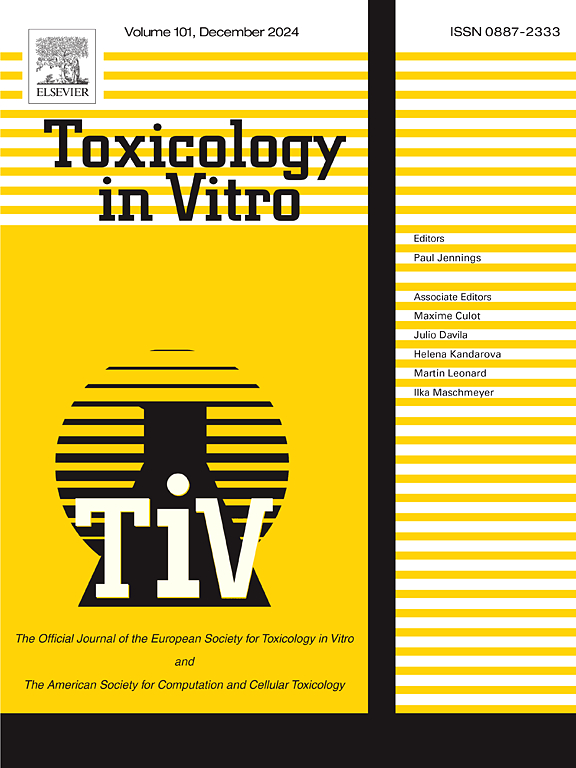腐胺的遗传毒性及其对HepG2细胞基因表达的影响。
IF 2.6
3区 医学
Q3 TOXICOLOGY
引用次数: 0
摘要
分解的尸体会释放出坏死性渗滤液,这是一种含有有害化合物的有毒液体,如生物胺。本研究通过彗星试验、微核试验和基因表达分析,研究了不同浓度(0.5、1.4、2.3、3.2 mM)的生物胺腐胺对HepG2细胞的遗传毒性作用。负控制的结果进行了比较和彗星试验突出显示重要的DNA损伤尾部DNA强度表现出显著差异在所有测试浓度(0.5 = 192 % 1.4 = 189 % 2.3 = 208 %,132年3.2 = %)。微核试验显示浓度为0.5(193 %)、1.4(229 %)、2.3(206 %)的微核显著增加;核芽3.2(173 %);染色体桥3.2(735 %)。此外,与氧化应激和DNA损伤相关的基因表现出统计学上显著的表达改变。这些发现表明腐胺对人源性HepG2细胞具有潜在的遗传毒性,引起了人们对墓地污染物的职业和环境风险的关注。这项研究首次评估了腐胺作为一种环境污染物的毒性,因为以前的研究主要集中在它在食品部门的作用上。这些见解突出了墓地渗滤液对环境健康的潜在威胁,强调了进一步研究墓地污染的必要性。本文章由计算机程序翻译,如有差异,请以英文原文为准。
Genotoxicity of putrescine and its effects on gene expression in HepG2 cell line
Decomposing bodies release necro-leachate, a toxic fluid containing harmful compounds such as biogenic amines. This study investigated the genotoxic effects of the different concentrations (0.5, 1.4, 2.3, 3.2 mM) of bioamine putrescine on HepG2 cells using the comet assay, the micronucleus test, and gene expression analysis. The results were compared to negative control and indicated significant DNA damage in the comet assay highlighting tail DNA intensity that exhibited significant differences across all tested concentrations (0.5 = 192 %, 1.4 = 189 %, 2.3 = 208 %, 3.2 = 132 %). The micronucleus test revealed a significant increase in micronuclei for concentrations 0.5 (193 %), 1.4 (229 %), 2.3 (206 %); nuclear buds 3.2 (173 %); chromosomal bridges 3.2 (735 %). Furthermore, genes linked to oxidative stress and DNA damage exhibited statistically significant expression alterations. These findings suggest that putrescine has genotoxic potential in human-derived HepG2 cells, raising concerns about cemetery contaminants' occupational and environmental risks. This study is the first to assess putrescine's toxicity as an environmental pollutant, as previous research has mainly focused on its role in the food sector. These insights highlight the potential threats necro-leachate poses to environmental health, emphasizing the need for further research on cemetery pollution.
求助全文
通过发布文献求助,成功后即可免费获取论文全文。
去求助
来源期刊

Toxicology in Vitro
医学-毒理学
CiteScore
6.50
自引率
3.10%
发文量
181
审稿时长
65 days
期刊介绍:
Toxicology in Vitro publishes original research papers and reviews on the application and use of in vitro systems for assessing or predicting the toxic effects of chemicals and elucidating their mechanisms of action. These in vitro techniques include utilizing cell or tissue cultures, isolated cells, tissue slices, subcellular fractions, transgenic cell cultures, and cells from transgenic organisms, as well as in silico modelling. The Journal will focus on investigations that involve the development and validation of new in vitro methods, e.g. for prediction of toxic effects based on traditional and in silico modelling; on the use of methods in high-throughput toxicology and pharmacology; elucidation of mechanisms of toxic action; the application of genomics, transcriptomics and proteomics in toxicology, as well as on comparative studies that characterise the relationship between in vitro and in vivo findings. The Journal strongly encourages the submission of manuscripts that focus on the development of in vitro methods, their practical applications and regulatory use (e.g. in the areas of food components cosmetics, pharmaceuticals, pesticides, and industrial chemicals). Toxicology in Vitro discourages papers that record reporting on toxicological effects from materials, such as plant extracts or herbal medicines, that have not been chemically characterized.
 求助内容:
求助内容: 应助结果提醒方式:
应助结果提醒方式:


